Educational Tutorial: Low Molecular Weight Heparin in Recurrent Abortions
Review information on low molecular weight heparin in recurrent miscarriages in this educational tutorial.

1. Prof. Veena Agrawal
M.D., MICOG, WHO Fellow USA , Dip in USG
Head of Dept of Obst. & Gynaec
G. R. Medical College, Gwl, M.P. India
Faculty of human Genetics, Jiwaji University Gwl
Past President Gwalior Obst & Gynae Society
Dr Sonali Agrawal
Senior Resident Dept of Obst. & Gynaec
G. R. Medical College, Gwl , M.P
Download the .PPT version of this presentation for off line viewing (512.5 KB)
Return to Power Point Presentations Indexsubmit your own material for publication via email with your files attached
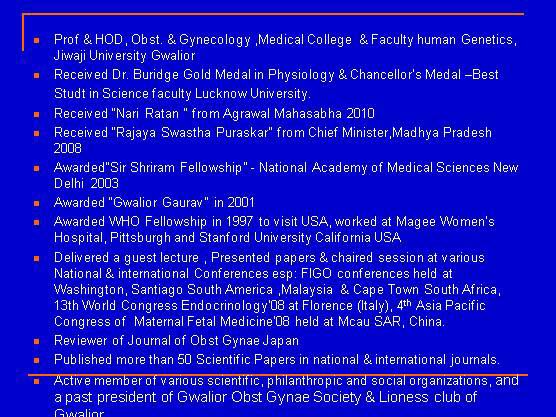
2.
- Prof & HOD, Obst. & Gynecology ,Medical College & Faculty human Genetics, Jiwaji University Gwalior
- Received Dr. Buridge Gold Medal in Physiology & Chancellor's Medal –Best Studt in Science faculty Lucknow University.
- Received "Nari Ratan " from Agrawal Mahasabha 2010
- Received "Rajaya Swastha Puraskar" from Chief Minister,Madhya Pradesh 2008
- Awarded"Sir Shriram Fellowship" - National Academy of Medical Sciences New Delhi 2003
- Awarded "Gwalior Gaurav" in 2001
- Awarded WHO Fellowship in 1997 to visit USA, worked at Magee Women's Hospital, Pittsburgh and Stanford University California USA
- Delivered a guest lecture , Presented papers & chaired session at various National & international Conferences esp: FIGO conferences held at Washington, Santiago South America ,Malaysia & Cape Town South Africa, 13th World Congress Endocrinology'08 at Florence (Italy), 4th Asia Pacific Congress of Maternal Fetal Medicine'08 held at Mcau SAR, China.
- Reviewer of Journal of Obst Gynae Japan
- Published more than 50 Scientific Papers in national & international journals.
- Active member of various scientific, philanthropic and social organizations, and a past president of Gwalior Obst Gynae Society & Lioness club of Gwalior
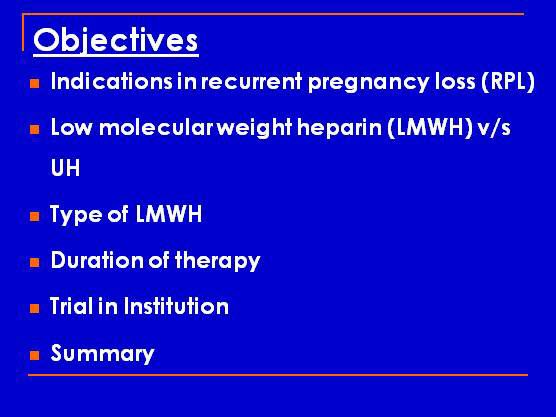
3. Objectives
- Indications in recurrent pregnancy loss (RPL)
- Low molecular weight heparin (LMWH) v/s UH
- Type of LMWH
- Duration of therapy
- Trial in Institution
- Summary
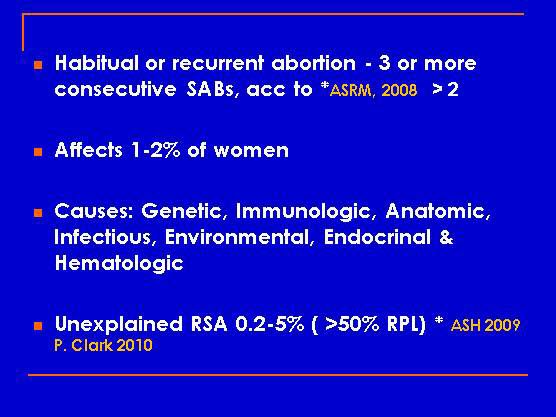
4.
- Habitual or recurrent abortion - 3 or more consecutive SABs, acc to ASRM, 2008 > 2
- Affects 1-2% of women
- Causes: Genetic, Immunologic, Anatomic, Infectious, Environmental, Endocrinal & Hematologic
- Unexplained RSA 0.2-5% ( >50% RPL) * ASH 2009 P. Clark 2010
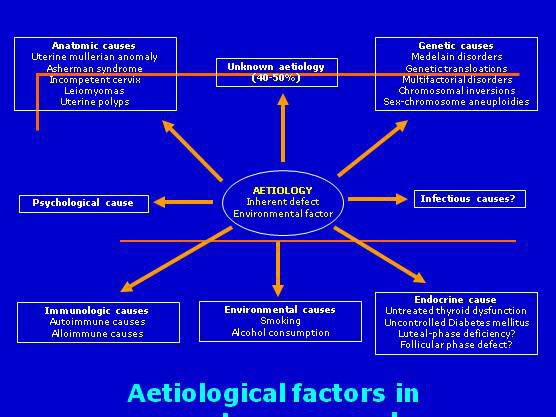
5. Aetiological factors in recurrent pregnancy loss
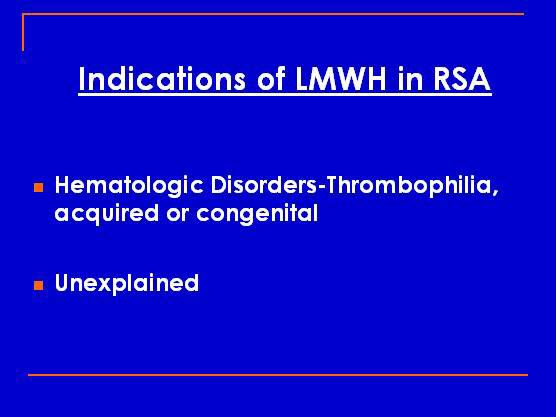
6. Indications of LMWH in RSA
- Hematologic Disorders-Thrombophilia, acquired or congenital
- Unexplained

7. Hemostatic Balance
- Natural anticoagulants (Protein C, Protein S, AT-III) Fibrinolytic factors
- Coagulation factors Platelets Fibrinolytic inhibitors
- Hypercoagulability

8. Pregnancy is a Hypercoagulable State
Thrombogenicity
- ↑se in procoagulant factors - VII, VIII, X, and fibrinogen, as early as 12 weeks
- Fibrinolytic activity is ↓sed - progressively ↑sing PAI-1, PAI-2
- Platelet activation & ↑sed production of thromboxane
Anticoagulants
- Protein S ↓se by 40-50%, while antithrombin III & protein C remain constant.
- ↓sed sensitivity to antiaggregation effects of prostacyclin
- Vasorelaxation
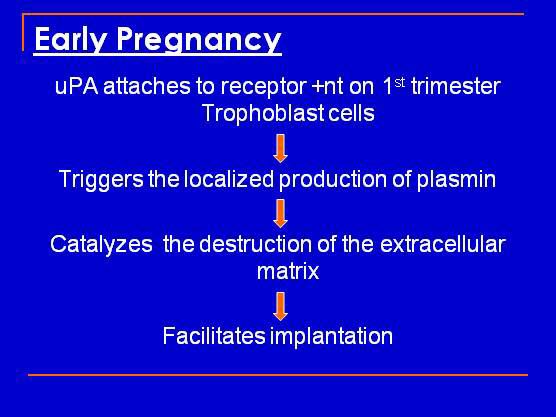
9. Early Pregnancy
- uPA attaches to receptor +nt on 1st trimester Trophoblast cells
- Triggers the localized production of plasmin
- Catalyzes the destruction of the extracellular matrix
- Facilitates implantation

10. Pathophysiology of Haematological / Unexplained RSA
- Not fully elucidated

11.
- Microthrombi is common in the placental vasculature(Rushton 1988)
- Placental thrombosis association with thrombophilic defects (Rai et al 1996: Dizon et al 1997)
- Defective decidual endovascular trophoblast invasion (Quenby et al 2004; van den Brule et al., 2005)
- Cadherins (E and β ), integrins, & selectins participate embryogenesis, cell growth & differentiation (Frenette & Wagner 1996. Shih et al. 2002)
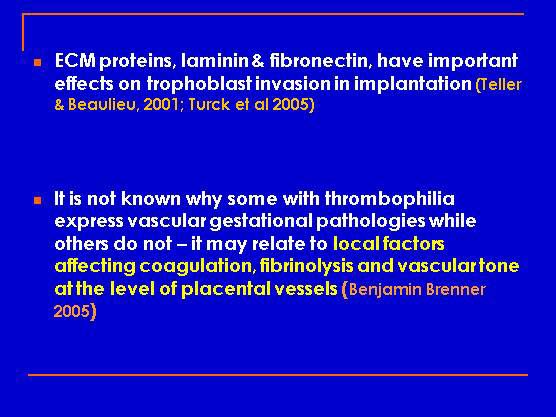
12.
- ECM proteins, laminin & fibronectin, have important effects on trophoblast invasion in implantation (Teller & Beaulieu, 2001; Turck et al 2005)
- It is not known why some with thrombophilia express vascular gestational pathologies while others do not – it may relate to local factors affecting coagulation, fibrinolysis and vascular tone at the level of placental vessels (Benjamin Brenner 2005)
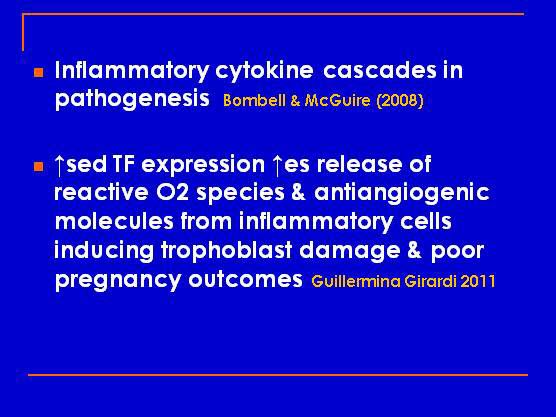
13.
- Inflammatory cytokine cascades in pathogenesis Bombell & McGuire (2008)
- ↑sed TF expression ↑es release of reactive O2 species & antiangiogenic molecules from inflammatory cells inducing trophoblast damage & poor pregnancy outcomes Guillermina Girardi 2011

14. How Heparin Works
- Potentiates the anti-thrombin effects, Jack Hirsh; 2001
- Binds to antiphospholipid antibodies rendering them inactive Di Simone N et al, 1999; Hum Reprod 1997
- Immunomodulatory action, by antagonising interferon gamma, a deleterious Th 1 cytokine Fritchley SJ, et al 2000
- Modulate trophoblast invasion by effecting ECM proteins & Cadherins Korhonen &Virtanen, 2001 Omer Erden 2006

15.
- Modulate trophoblast apoptosis suggesting a direct impact on trophoblast biology Patrick Bose 2005
- Inhibits complement activation Girardi Get al 2004
- Anti-inflammatory effect Jin-ping Li 2010

16. Efficacy in Hematologic & Unexplained RPL is?
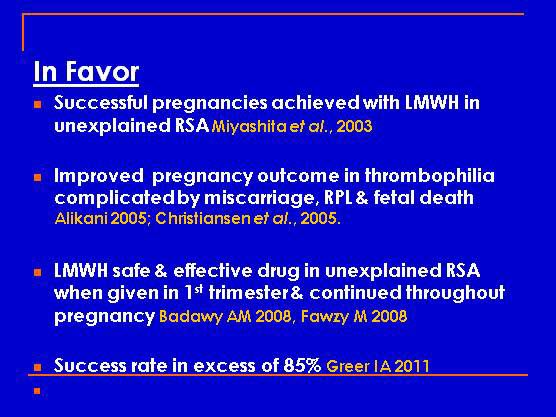
17. In Favor
- Successful pregnancies achieved with LMWH in unexplained RSA Miyashita et al., 2003
- Improved pregnancy outcome in thrombophilia complicated by miscarriage, RPL & fetal death Alikani 2005; Christiansen et al., 2005.
- LMWH safe & effective drug in unexplained RSA when given in 1st trimester & continued throughout pregnancy Badawy AM 2008, Fawzy M 2008
- Success rate in excess of 85% Greer IA 2011
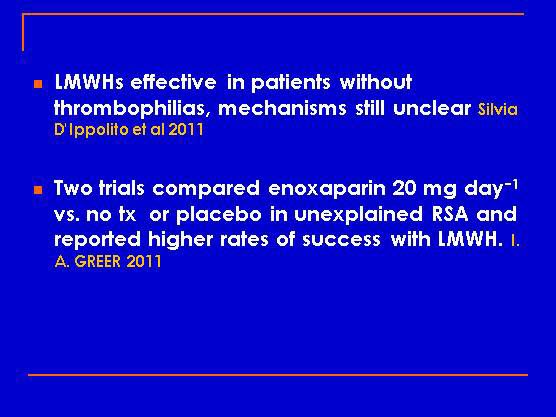
18.
- LMWHs effective in patients without thrombophilias, mechanisms still unclear Silvia D'Ippolito et al 2011
- Two trials compared enoxaparin 20 mg day−1 vs. no tx or placebo in unexplained RSA and reported higher rates of success with LMWH. I. A. GREER 2011

19. Against
- LMWH/ASA did not confer incremental benefit compared to ASA alone Carl A et al HepASA Trial 2009
- Regardless of tx regimen, no of prior losses, or aPL positivity, 80% of RPL cohort had a successful pregnancy outcome Carl A et al HepASA Trial 2009
- Anticoagulants is not recommended in unexplained two miscarriages without inherited thrombophilia Cochrane Database Syst Rev 2009
- Not advocated for unexplained RSA Robert W. Rebar, 2010
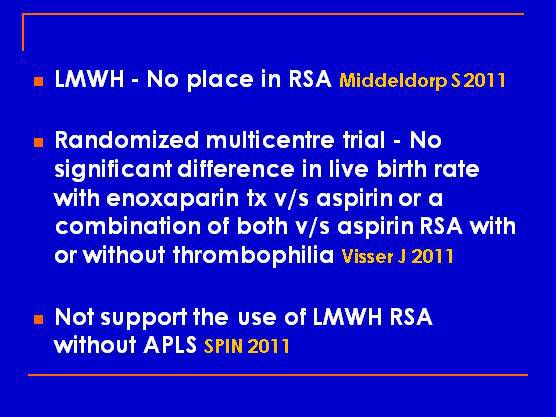
20.
- LMWH - No place in RSA Middeldorp S 2011
- Randomized multicentre trial - No significant difference in live birth rate with enoxaparin tx v/s aspirin or a combination of both v/s aspirin RSA with or without thrombophilia Visser J 2011
- Not support the use of LMWH RSA without APLS SPIN 2011
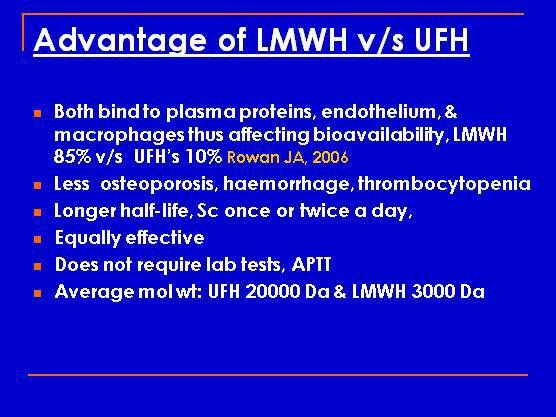
21. Advantage of LMWH v/s UFH
- Both bind to plasma proteins, endothelium, & macrophages thus affecting bioavailability, LMWH 85% v/s UFH's 10% Rowan JA, 2006
- Less osteoporosis, haemorrhage, thrombocytopenia
- Longer half-life, Sc once or twice a day,
- Equally effective
- Does not require lab tests, APTT
- Average mol wt: UFH 20000 Da & LMWH 3000 Da

22.
- Less effect on thrombin compared to UFH, but maintains same effect on Factor Xa.
- Easy route of self-administration
- Do not cross the placenta and has no teratogenic or fetotoxic risks or fetal bleeding
- lack of secretion in breast milk
- Anticoagulant effects of UFH are reversible with protamine sulphate, effect on LMWH is limited
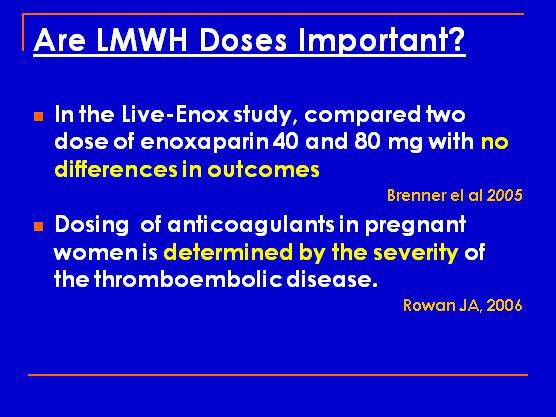
23. Are LMWH Doses Important?
- In the Live-Enox study, compared two dose of enoxaparin 40 and 80 mg with no differences in outcomes Brenner el al 2005
- Dosing of anticoagulants in pregnant women is determined by the severity of the thromboembolic disease. Rowan JA, 2006

24. Duration of Heparin Therapy
- Should not extend unnecessarily - osteopenia
- Monitor by platelet count, PTT &/or anti-Xa activity wkly for the first 3 wks & every 4±6 weeks thereafter
- Long-term use of LMWH in pregnancy well tolerated, with very low adverse effects Santoro, Rita 2009
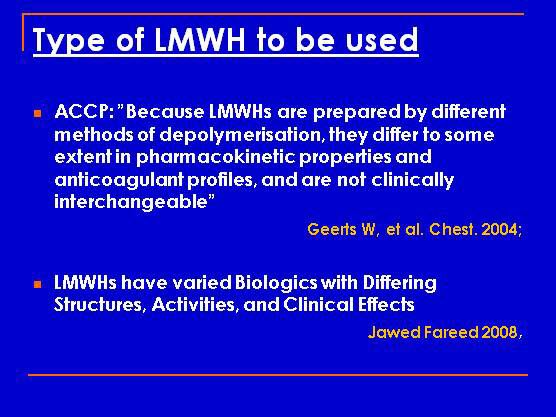
25. Type of LMWH to be used
- ACCP:"Because LMWHs are prepared by different methods of depolymerisation, they differ to some extent in pharmacokinetic properties and anticoagulant profiles, and are not clinically interchangeable" Geerts W, et al. Chest. 2004;
- LMWHs have varied Biologics with Differing Structures, Activities, and Clinical Effects Jawed Fareed 2008,
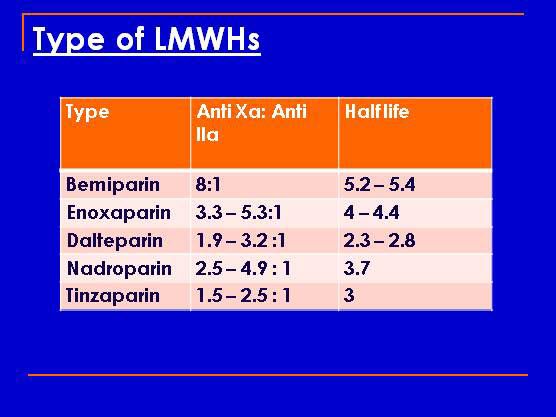
26. Type of LMWHs
- Bemiparin
- Enoxaparin
- Dalteparin
- Nadroparin
- Tinzaparin

27.
- Bemiparin
- Dalteparin
- Enoxaparin
- Nadroparin
- Tinzaparin

28. Bemiparin
- 2nd generation LMWH
- More advanced pharmacological profile
- Unknown whether crosses placental barrier
- Safe & resulted in improved gestational outcome, Santamara A. 2007
- No teratogenic effects in Animal studies, potential risk for humans is unknown 2010
- Safe, ↑ live birth rate & no maternal & fetal complications in prevention of APS RSA Alalaf S, 2011.
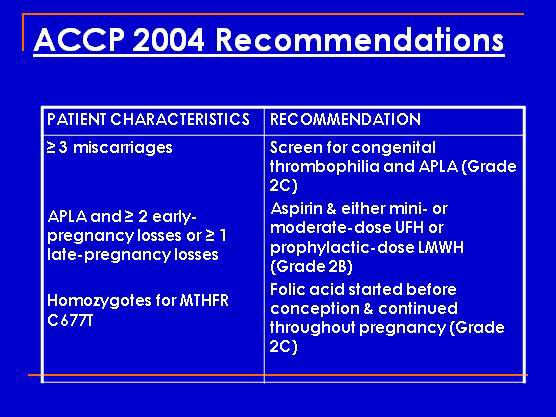
29. ACCP 2004 Recommendations
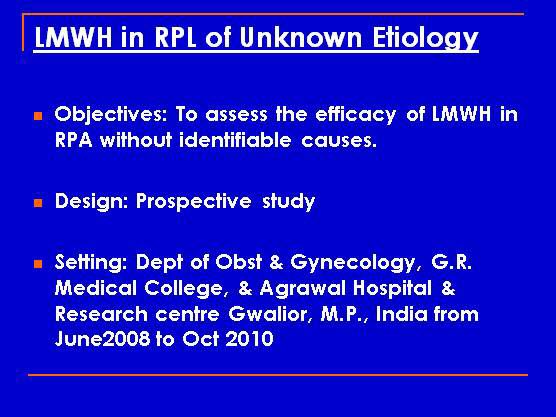
30. LMWH in RPL of Unknown Etiology
- Objectives: To assess the efficacy of LMWH in RPA without identifiable causes.
- Design: Prospective study
- Setting: Dept of Obst & Gynecology, G.R. Medical College, & Agrawal Hospital & Research centre Gwalior, M.P., India from June2008 to Oct 2010
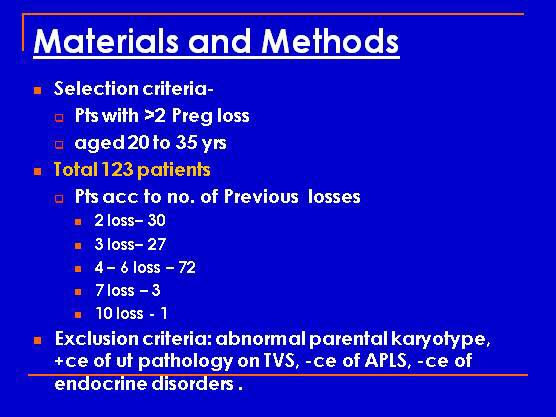
31. Materials and Methods
- Selection criteria-
- Pts with >2 Preg loss
- aged 20 to 35 yrs
- Total 123 patients
- Pts acc to no. of Previous losses
- 2 loss– 30
- 3 loss– 27
- 4 – 6 loss – 72
- 7 loss – 3
- 10 loss - 1
- Exclusion criteria: abnormal parental karyotype, +ce of ut pathology on TVS, -ce of APLS, -ce of endocrine disorders .
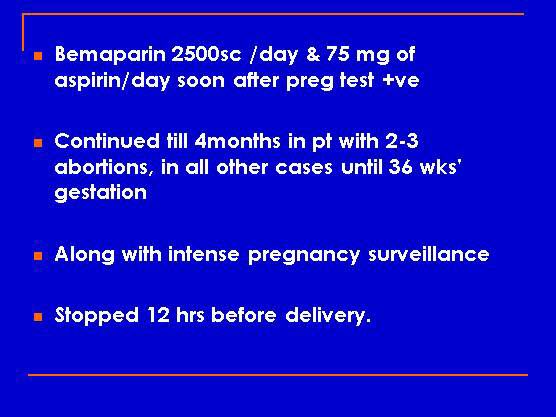
32.
- Bemaparin 2500sc /day & 75 mg of aspirin/day soon after preg test +ve
- Continued till 4months in pt with 2-3 abortions, in all other cases until 36 wks' gestation
- Along with intense pregnancy surveillance
- Stopped 12 hrs before delivery.
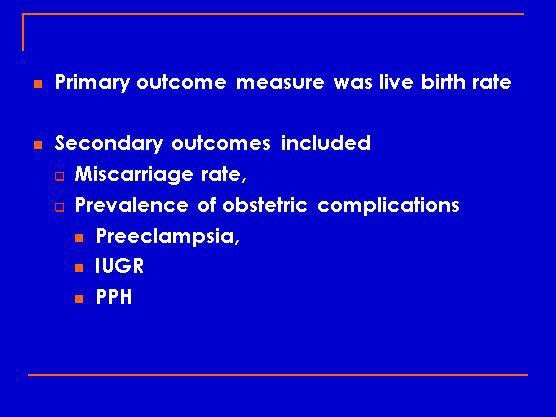
33.
- Primary outcome measure was live birth rate
- Secondary outcomes included
- Miscarriage rate,
- Prevalence of obstetric complications
- Preeclampsia,
- IUGR
- PPH

34. Results
- 103 pt had live birth i.e. 83%, more success in 4 and above losses
- Most of the miscarriages during the study occurred in the 1st trimester (93%) and 28% even before 7 weeks gestation
- PET is not more only in 5% cases
- IUGR – 10%
- Mild PPH – only in cases in which LMWH continued till 36 weeks' gestation

35. Conclusion
- Study provides good evidence that antithrombotic therapy should be advocated for unexplained recurrent miscarriage.
- Limitations of study:
- No controlled comparative placebo cases
- Not all causes of thrombophilia was excluded
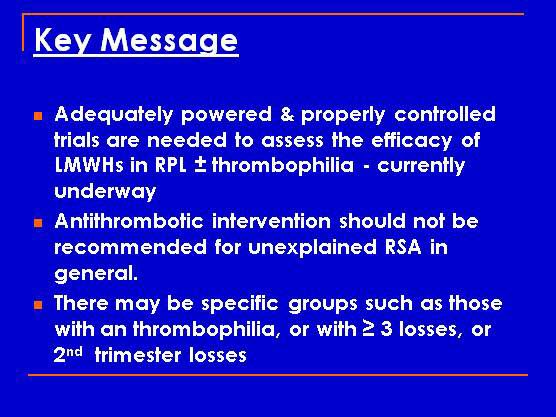
36. Key Message
- Adequately powered & properly controlled trials are needed to assess the efficacy of LMWHs in RPL ± thrombophilia - currently underway
- Antithrombotic intervention should not be recommended for unexplained RSA in general.
- There may be specific groups such as those with an thrombophilia, or with ≥ 3 losses, or 2nd trimester losses
Download the .PPT version of this presentation for off line viewing (512.5 KB)
Return to Power Point Presentations Indexsubmit your own material for publication via email with your files attached
S1E4: Dr. Kristina Adams-Waldorf: Pandemics, pathogens and perseverance
July 16th 2020This episode of Pap Talk by Contemporary OB/GYN features an interview with Dr. Kristina Adams-Waldorf, Professor in the Department of Obstetrics and Gynecology and Adjunct Professor in Global Health at the University of Washington (UW) School of Medicine in Seattle.
Listen
Study shows a healthy prenatal diet could be upstream obesity prevention strategy
December 26th 2024"Our findings support the recommendation of a healthy diet based on the current guidelines (as measured by the HEI) during pregnancy, since it may reduce patterns of infant growth outside reference ranges."
Read More
Early pregnancy cannabis use high in states with recreational legalization
November 11th 2024A population-based time-series analysis California before, during and after legalization show a rising trend in women using cannabis while pregnancy especially when the state has legalized the drug.
Read More
